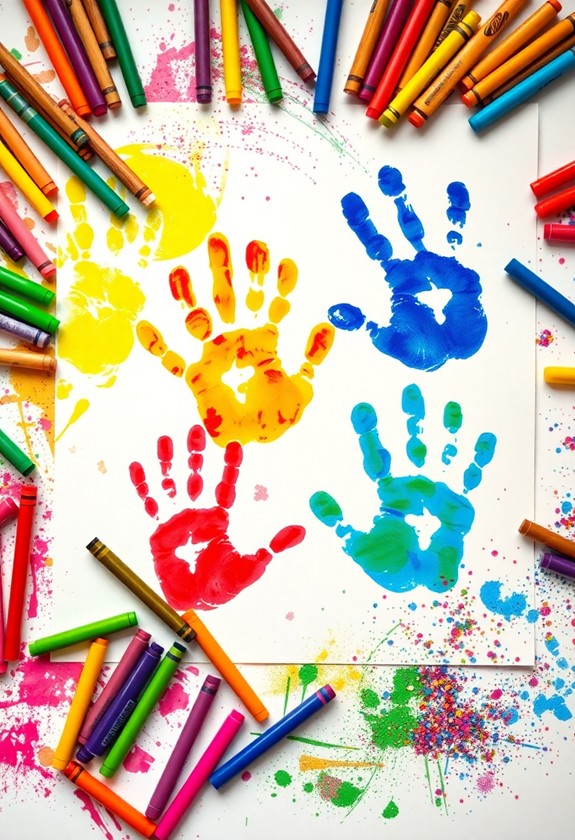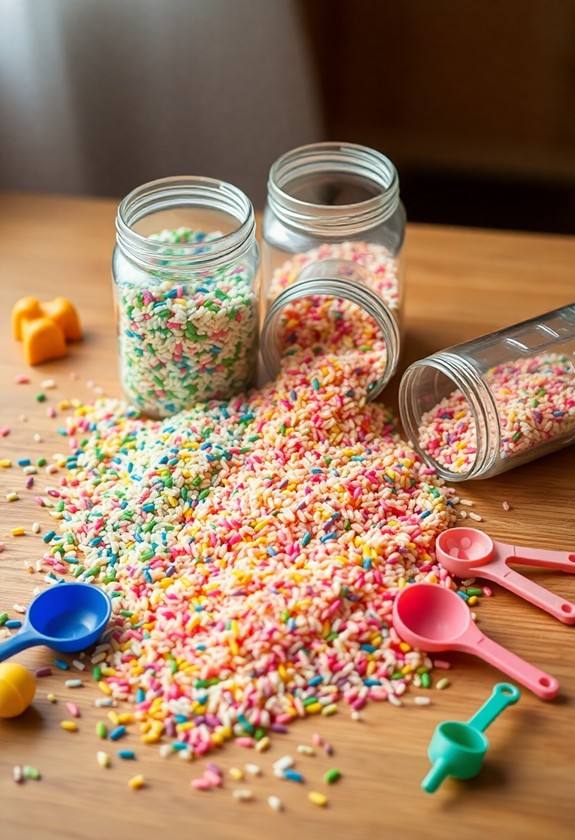Get ready for sensory fun with your little one! These 10 budget-friendly activities will spark your toddler's imagination and boost their development. Whip up homemade play dough for squishy creativity, or create colorful rice bins for tactile exploration. Try squishy sensory bags and water painting for mess-free excitement! Craft textured collages and bubble wrap prints to engage their artistic side. Don't forget edible finger painting for tasty creativity. Take a nature texture walk, or make mess-free sensory bottles for on-the-go fun. These activities are guaranteed to delight your toddler's senses and keep them engaged for hours. Jump in to uncover even more exciting details about each activity!
Creative Highlights
- Homemade play dough and edible finger paints provide safe, creative sensory experiences using common household ingredients.
- Squishy sensory bags and mess-free bottles offer portable, contained sensory play options for toddlers.
- Textured collage art and bubble wrap printing encourage tactile exploration while developing fine motor skills.
- Colorful rice bins and nature texture walks provide diverse sensory experiences using readily available materials.
- Water painting and indoor sand play offer engaging, low-mess alternatives for sensory exploration indoors and outdoors.
Homemade Play Dough
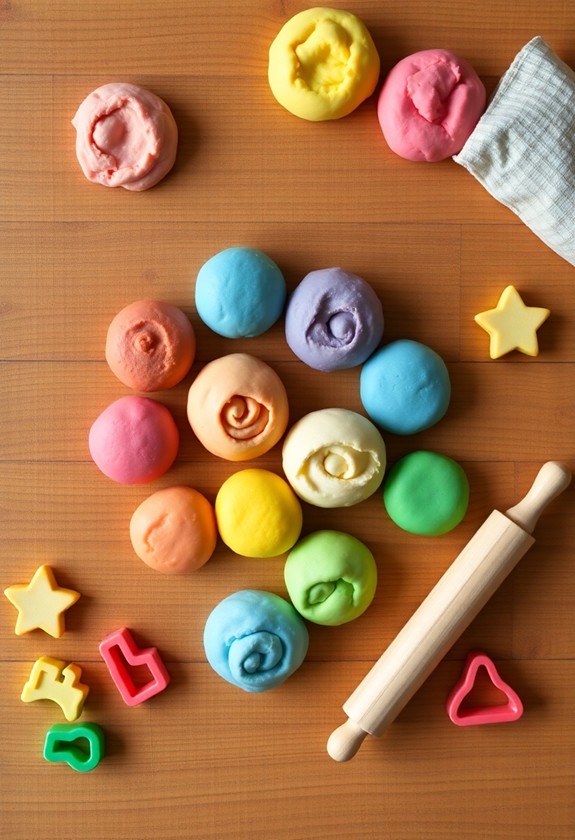
One of the most versatile and engaging sensory activities for toddlers is homemade play dough. It's super easy to make and provides hours of fun! Here's a simple recipe:
- 2 cups flour
- 1 cup salt
- 2 tablespoons oil
- 1.5 cups boiling water
- Food coloring (optional)
Mix dry ingredients, add oil and water, then knead until smooth. Voila! You've got play dough! This non-toxic, safe-to-eat recipe guarantees peace of mind as your little one investigates textures and colors.
Your little one will love squishing, rolling, and molding this squishy delight. It's a fantastic way to develop fine motor skills and creativity. Plus, it's safe if they accidentally taste it (though it's not yummy!).
Spice things up by adding glitter, key oils, or small toys for hide-and-seek fun. The possibilities are endless! Get ready for some dough-lightful playtime!
Colorful Rice Bins
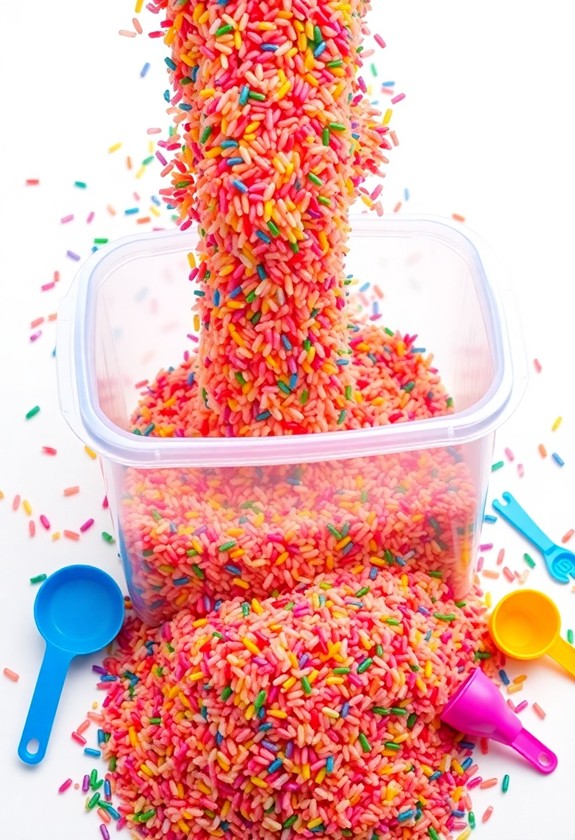
As play dough offers a tactile experience, colorful rice bins provide a whole new sensory adventure for your toddler. Get ready for a rice-tastic time! This activity not only enhances creativity but additionally supports cognitive development through problem-solving tasks. Here's how to create this exciting activity:
- Grab some uncooked rice and food coloring
- Mix rice with different colors in separate bags
- Let it dry completely (overnight is best)
- Pour the colorful rice into a large bin or container
Now, watch your little one immerse themselves! They'll love running their hands through the rice, scooping it up, and letting it rain down. Add some small toys, cups, or spoons for extra fun. It's a-maize-ing how much they'll learn about textures, colors, and cause-and-effect. Plus, it's easy to clean up – just vacuum any spills. Rice to meet you, sensory play!
Squishy Sensory Bags

Squish, squeeze, and examine with squishy sensory bags! These handy little pouches are a collection of tactile fun for your toddler. Here's how to make them:
- Fill a ziplock bag with hair gel, shaving cream, or paint
- Add small, colorful objects like buttons or beads
- Seal tightly and tape the edges for extra security
Let your little one investigate the squishy contents through the bag. They'll love pressing, poking, and moving the items around! For added excitement, try these variations:
- Glow-in-the-dark: Use fluorescent paint for a magical effect
- Seasonal themes: Add fall leaves or spring flowers
- Letters and numbers: Include foam shapes for learning
These bags are perfect for sensory play on-the-go. Plus, they're mess-free! Your toddler will have a squish-tastic time developing their fine motor skills and sensory awareness.
Water Painting

Even though traditional painting can be messy and expensive, water painting offers a clean, cost-effective alternative for toddlers to explore their creativity. It's so easy to set up! Just grab a bucket of water, some paintbrushes, and head outside. Your little artist can "paint" on sidewalks, fences, or even the side of your house! Water painting is not only fun but also promotes skill development in fine motor control and hand-eye coordination. The best part? It dries quickly and leaves no mess behind.
Here's how to make it extra fun:
- Use different-sized brushes for varied strokes
- Try "painting" letters or shapes
- Make it a race against evaporation!
Water painting isn't just artsy – it's a sensory bonanza! Your toddler will feel the cool water, see their creations appear (and disappear), and experience the joy of mark-making. It's a splashing good time that'll have them begging for more!
Textured Collage Art

Though water painting offers a mess-free artistic experience, textured collage art lets your toddler examine a variety of sensations through touch. It's super easy to set up and loads of fun! Gather materials with different textures like fabric scraps, feathers, sandpaper, and crinkly paper. Let your little one discover these textures and create a masterpiece! Creative indoor crafts like this are perfect for rainy days or when you need a quiet activity at home.
Here's how to get started:
- Lay out a piece of sturdy cardboard or paper as the base
- Offer a selection of textured materials in small containers
- Provide child-safe glue or a glue stick
- Encourage your toddler to stick items onto the base
Watch as your child's eyes light up with each new texture! They'll love squishing, crinkling, and patting different materials. This activity is a tactile adventure that'll have them giggling with glee!
Indoor Sand Play
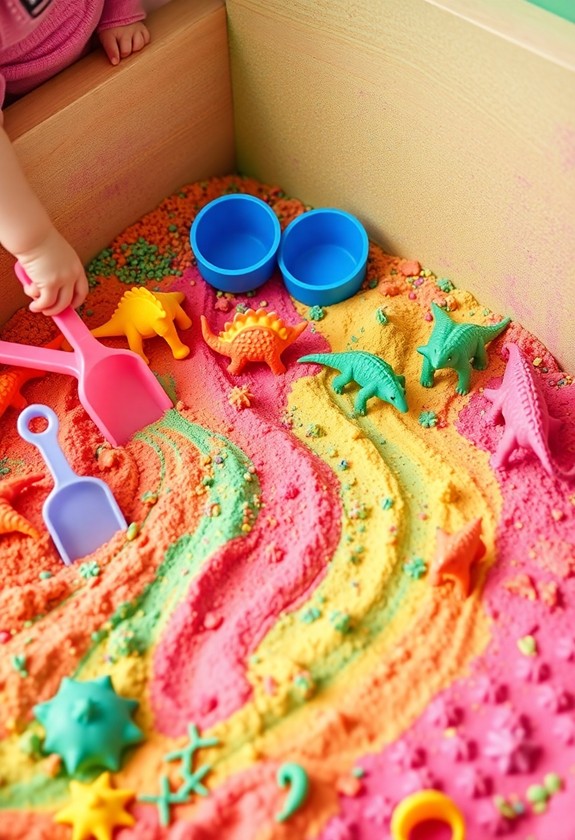
Indoor sand play brings the beach to your living room without the mess. It's a fantastic way to engage your toddler's senses and spark their creativity! Here's how to set it up:
- Find a large, shallow container
- Fill it with kinetic sand (it's less messy!)
- Add small toys like:
- Plastic animals
- Seashells
- Toy trucks
Let your little one dig, mold, and investigate! They'll love the unique texture and endless possibilities. Watch as they build sandcastles, create roads, or bury treasure. It's a "sand-sational" activity that'll keep them entertained for hours!
Pro tip: Place a tablecloth under the container for easy cleanup. And don't forget to join in the fun! Building memories is just as important as building sand structures. Your toddler will be "shore" to love this indoor beach adventure!
Bubble Wrap Printing

From bubble wrap to beautiful art, this activity transforms a common packing material into a creative tool for toddlers. It's easy, fun, and oh-so-satisfying! Here's what you'll need:
- Bubble wrap
- Washable paint
- Paper
- Paintbrush or roller
Start by cutting the bubble wrap into manageable pieces. Then, let your little one go wild! They can use a brush or roller to apply paint directly to the bubbles. For a mess-free alternative, consider using special color-revealing paints that only show up on designated surfaces. Press the painted bubble wrap onto paper, and voila! A unique, textured masterpiece emerges. But wait, there's more! Try different colors, patterns, or even use the bubble wrap as a stamp. The possibilities are endless! This activity isn't just about art – it's a sensory explosion that'll have your toddler giggling with glee. Plus, it's a great way to practice fine motor skills and color recognition. Let the bubble wrap bonanza begin!
Edible Finger Painting

Every parent knows that toddlers love to explore with their hands—and mouths. That's why edible finger painting is a perfect sensory activity! It's safe, fun, and oh-so-messy (in the best way possible)!
Here's how to create your own edible paint:
- Mix equal parts cornstarch and water
- Add a few drops of food coloring
- Stir until smooth
Voila! You've got paint that's safe to taste. Spread it on a tray or table, and let your little Picasso go wild! They'll love squishing, spreading, and yes, even sampling their masterpiece.
Pro tip: Add different textures by mixing in rice, oatmeal, or pudding. It's a recipe for tactile exploration and giggles galore! Just be prepared for a colorful cleanup—but that's half the fun, right?
Nature Texture Walk

While indoor activities are fun, stepping outside can offer a wealth of sensory experiences for your toddler. A nature texture walk is a fantastic way to engage their senses and investigate the great outdoors! Here's how to make the most of this exciting adventure:
- Gather supplies: Bring a bag, magnifying glass, and paper for rubbings.
- Choose a diverse location: Parks, beaches, or your backyard work great!
- Encourage touching and describing: Let your little one feel bark, leaves, and rocks.
- Collect natural treasures: Pick up interesting items to examine later.
As you stroll, point out different textures and ask your toddler to describe them. Is the grass tickly? Does the sand feel gritty? This activity isn't just a walk in the park – it's a sensory explosion! Your child will be tree-mendously excited to uncover nature's tactile wonders!
Mess-Free Sensory Bottles

Curiosity drives toddlers to explore their world, but sometimes their inquiries can lead to messy situations. That's where mess-free sensory bottles come in! These magical containers are a toddler's dream come true, offering endless exploration without the cleanup.
Creating these bottles is a breeze! Here's what you'll need:
- Clear plastic bottles
- Water
- Food coloring
- Glitter, sequins, or small toys
- Hot glue gun
Simply fill the bottles with water, add a few drops of food coloring, and toss in your chosen objects. Seal the cap with hot glue, and voilà! You've got a portable sensory wonderland.
Watch your little one's eyes light up as they shake, roll, and observe these enchanting bottles. They'll be mesmerized by the swirling colors and floating objects. It's sensory stimulation without the stress!
Curious Little Questions
How Can I Incorporate Sensory Activities Into My Toddler's Daily Routine?
"Out of sight, out of mind" doesn't apply here! You can easily weave sensory activities into your toddler's day. Try these fun ideas:
- Bath time bubbles for squishy fun!
- Finger painting during art time
- Sand or water play outdoors
- Textured books at story time
- Playdough sculpting for tactile exploration
Mix it up! Use different scents, textures, and sounds. Don't forget taste – try safe food explorations too. Your little one will be "sensing" the world in no time!
What Are the Cognitive Benefits of Sensory Play for Toddlers?
Wow, sensory play is a brain-boosting bonanza for your little one! You'll be amazed at how it:
- Sparks curiosity and problem-solving skills
- Boosts language development and vocabulary
- Improves memory and attention span
- Improves fine motor skills and coordination
- Builds confidence and social skills
It's like a fun, messy gym for your toddler's growing mind! Through touching, smelling, and investigating different textures and materials, your child's brain is making connections at lightning speed. It's cognitive growth in action, and it's absolutely fantastic!
At What Age Should I Introduce Sensory Activities to My Child?
You've been waiting for the perfect age to start sensory activities? Well, surprise! It's already here! Believe it or not, you can begin introducing sensory play as early as birth. That's right, from day one! Your baby's senses are developing rapidly, and they're ready to investigate. Start with simple activities like:
- Gentle touch with different textures
- Soft music or soothing sounds
- Colorful mobiles or contrast cards
As your little one grows, you can gradually introduce more complex sensory experiences. It's never too early to start!
How Can I Make Sensory Play Inclusive for Children With Special Needs?
You can make sensory play inclusive for children with special needs by:
- Adapting activities to suit each child's abilities
- Using large, easy-to-grasp objects for kids with motor challenges
- Offering noise-cancelling headphones for sound-sensitive children
- Providing visual schedules to help with transitions
- Creating calm, distraction-free spaces for focused play
Are There Any Safety Concerns I Should Be Aware of During Sensory Play?
Safety first, sensory adventurers! You'll want to keep a watchful eye during playtime. Here are some quick tips:
- Always supervise your little ones
- Avoid small objects that could be choking hazards
- Be careful with edible materials – no nibbling!
- Watch out for allergies, especially with food-based play
- Keep things clean to prevent germ spread


